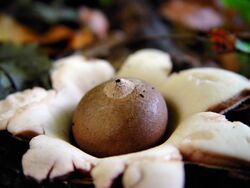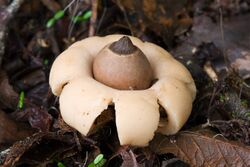Biology:Geastrum
| Geastrum | |
|---|---|

| |
| Geastrum triplex | |

| |
| Geastrum saccatum | |
| Scientific classification | |
| Domain: | Eukaryota |
| Kingdom: | Fungi |
| Division: | Basidiomycota |
| Class: | Agaricomycetes |
| Order: | Geastrales |
| Family: | Geastraceae |
| Genus: | Geastrum Pers. |
| Type species | |
| Geastrum coronatum Pers.
| |
| Species | |
|
About 50; See text | |
Geastrum (orthographical variant Geaster)[1] is a genus of puffball-like mushrooms in the family Geastraceae. Many species are commonly known as earthstars.
The name, which comes from geo meaning earth and aster meaning star, refers to the behavior of the outer peridium. At maturity, the outer layer of the fruiting body splits into segments which turn outward creating a star-like pattern on the ground. The inner peridium is called a spore sac. In some species, the outer peridium splits from a middle layer, causing the spore sac to arch off the ground. If the outer peridium opens when wet and closes when dry, it is described as hygroscopic.
In some species, the inner peridium is borne on a stalk or pedicel. The columella is a column-like clump of sterile tissue found inside the inner peridium. The network of fertile tissue inside the inner peridium, the capillitium, arises from the columella. This is where basidia and basidiospores are produced. The mouth in most species of "earth-stars" is quite prominent, often arising as a small cone at the apex of the inner peridium. It may be even or sulcate (grooved).[2]
They are generally not toxic but considered non-edible due to their fibrous texture in the mature stage at which they are generally found.
Species
Although the Dictionary of the Fungi (2008) estimated roughly 50 species in Geastrum,[3] a more recent estimate (2014) suggests that there may be up to 120 species.[4] Geastrum coronatum Pers. has been proposed as the conserved type for the genus.[5] Some similar species that are otherwise difficult to differentiate using classical morphological features (such as G. triplex, G. saccatum, and G. lageniforme) can be identified using chemical spot tests that detect phenoloxidase enzymatic activity, a differences in the crystal structure of calcium oxalate deposits[6] or DNA sequences. Species include:
- Geastrum aculeatum[7]
- Geastrum albonigrum
- Geastrum andrewsii
- Geastrum argentatum
- Geastrum argentinum
- Geastrum australe
- Geastrum austrominimum
- Geastrum benitoi
- Geastrum britannicum
- Geastrum berkeleyi
- Geastrum bushnellii
- Geastrum campestre
- Geastrum clelandii
- Geastrum congolense
- Geastrum corollinum
- Geastrum coronatum
- Geastrum dissimile
- Geastrum drummondii
- Geastrum dubowskii
- Geastrum echinulatum[7]
- Geastrum elegans
- Geastrum elliptice
- Geastrum entomophilum[8]
- Geastrum episcopale
- Geastrum fimbriatum
- Geastrum flexuosum
- Geastrum floriforme
- Geastrum fornicatum
- Geastrum fuscogleba
- Geastrum hieronymi
- Geastrum hirsutum
- Geastrum huneckii
- Geastrum hungaricum
- Geastrum inpaense – Brazil[9]
- Geastrum kotlabae
- Geastrum kuharii
- Geastrum lageniforme
- Geastrum leptospermum
- Geastrum lilloi[10]
- Geastrum litchiforme
- Geastrum lloydianum
- Geastrum magnosporum[11]
- Geastrum melanocephalum[12]
- Geastrum meridionale
- Geastrum minimum
- Geastrum mirabile
- Geastrum morganii
- Geastrum ovalisporum
- Geastrum oxylobum
- Geastrum papinuttii
- Geastrum parvisporum
- Geastrum parvistriatum
- Geastrum pectinatum
- Geastrum pleosporus[13]
- Geastrum pouzarii
- Geastrum pseudolimbatum
- Geastrum quadrifidum
- Geastrum reticulatum
- Geastrum rhizophorum
- Geastrum rufescens
- Geastrum rugulosum
- Geastrum rusticum – Brazil[14]
- Geastrum saccatum
- Geastrum schmidelii
- Geastrum schweinitzii
- Geastrum senoretiae[15]
- Geastrum setiferum
- Geastrum smardae
- Geastrum smithii
- Geastrum stiptatum
- Geastrum striatum
- Geastrum subiculosum
- Geastrum tichifer
- Geastrum triplex
- Geastrum velutinum
- Geastrum verrucoramulosum[16]
- Geastrum welwitschii
- Geastrum xerophilum
- Geastrum xylogenum
References
- ↑ Demoulin V. (1984). "Typification of Geastrum Pers.: Pers. and its orthographic variant Geaster (Gasteromycetes)". Taxon 33 (3): 498–501. doi:10.2307/1220990.
- ↑ Johnson MM. (1928). "The Gasteromycetae of Ohio". Ohio Biological Survey Bulletin 22 4 (7): 271–352.
- ↑ Dictionary of the Fungi (10th ed.). Wallingford, UK: CAB International. 2008. p. 274. ISBN 978-0-85199-826-8.
- ↑ "Systematics of the genus Geastrum (Basidiomycota, Fungi) revisited". Taxon 63 (3): 477–97. 2014. doi:10.12705/633.36.
- ↑ Zamora, J.C.. "Proposal to conserve the name Geastrum (Basidiomycota, Geastrales) with a conserved type". Taxon 63 (3): 679–680. doi:10.12705/633.22.
- ↑ "New sources of taxonomic information for earthstars (Geastrum, Geastraceae, Basidiomycota): phenoloxidases and rhizomorph crystals". Phytotaxa 132 (1): 1–20. 2013. doi:10.11646/phytotaxa.132.1.1.
- ↑ 7.0 7.1 "Two new species of Geastrum (Geastraceae, Basidiomycota) found in Brazil". Nova Hedwigia 96 (3–4): 445–56. 2013. doi:10.1127/0029-5035/2013/0089. http://ppbio.inpa.gov.br/sites/default/files/11_Silva_445_456_wm.pdf.
- ↑ "Geastrum entomophilum, a new earthstar with an unusual spore dispersal strategy". Mycotaxon 104: 449–53. 2008.
- ↑ "A new species and new records of gasteroid fungi (Basidiomycota) from Central Amazonia, Brazil". Phytotaxa 184 (4): 239–53. 2014. doi:10.11646/phytotaxa.183.4.3.
- ↑ Domínguez De Toledo; Laura S. (1996). "Geastrum lilloi sp. nov. from Argentina". Mycologia 88 (5): 858–62. doi:10.2307/3760982. http://www.cybertruffle.org.uk/cyberliber/59350/0088/005/0858.htm.
- ↑ "Fungal Planet description sheets: 716-784.". Persoonia 40: 240–393. 2018. doi:10.3767/persoonia.2018.40.10. PMID 30505003. PMC 6146637. https://www.ingentaconnect.com/content/nhn/pimj/2018/00000040/00000001/art00011.
- ↑ "Phylogenetic placement of Geastrum melanocephalum and polyphyly of Geastrum triplex". Mycoscience 53 (6): 411–426. 2012. doi:10.1007/s10267-012-0186-z.
- ↑ "Geastrum pleosporus sp nov., a new species of Geastraceae identified by morphological and molecular phylogenetic data". Mycological Progress 4 (3): 239–50. 2005. doi:10.1007/s11557-006-0127-3.
- ↑ "Geastrum rusticum (Geastraceae, Basidiomycota), a new earthstar fungus in the Brazilian Atlantic rainforest − a molecular analysis". Nova Hedwigia 98 (1–2): 265–72. 2014. doi:10.1127/0029-5035/2013/0158.
- ↑ "Combining morphological and phylogenetic analyses to unravel systematics in Geastrum sect. Schmidelia". Mycologia 106 (6): 1199–211. 2014. doi:10.3852/14-072. PMID 25152001.
- ↑ "A remarkable new species of Geastrum with an elongated branched stipe". Mycoscience 58 (5): 344–350. 2017. doi:10.1016/j.myc.2017.03.004.
Sources
- New Zealand Species
- British Species
- Czech Species and Photos
- "Geastrum Pers.". Atlas of Living Australia. https://bie.ala.org.au/species/urn:lsid:indexfungorum.org:names:19141.
- "Geastraceae". Virtual Herbarium, Steere Herbarium. New York Botanical Garden. http://sciweb.nybg.org/Science2/hcol/lists/geastraceae.html.
- Ponce de Leon, Patricio, A Revision of the Family Geastraceae, Field Museum of Natural History 1968
- Bates, Scott T. (December 2004). Arizona members of the Geastraceae and Lycoperdaceae (Basidiomycota, Fungi) (Masters). Arizona State University.
- Sunhede, Stellan (1989). Geastraceae (Basidiomycotina): Morphology, Ecology and Systematics, with Special Emphasis on the North European Species. Fungiflora. ISBN 978-82-90724-05-9. https://books.google.com/books?id=A_NEAAAAYAAJ.
Wikidata ☰ Q687050 entry
 |

